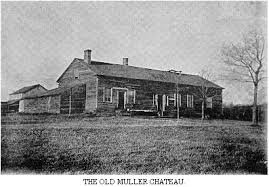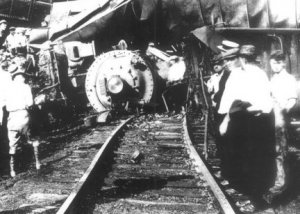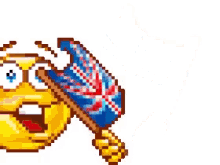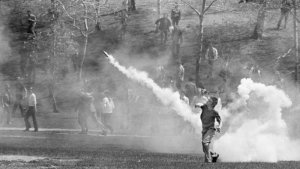I live in Connecticut. Nothing ever happened here.
 1.
1. The word “Connecticut” is an anglicized spelling of the Algonquian word “quinnitukqut,” roughly meaning “at the long tidal river.”
2. Connecticut is officially known as the Constitution State, referring to the state government-establishing Fundamental Orders of Connecticut. Written in 1639, the Fundamental Orders is considered history's first written constitution.
Connecticut is also known as the "Nutmeg State." Traditionally, sailors brought the seed back from long voyages and, over time, peddlers from the state developed the reputation for selling fake nutmegs made out of carved wood.
3. Connecticut’s state song is “Yankee Doodle.” The scrappy lyrics to the historic tune allegedly came from a British surgeon named Dr. Richard Shuckburgh who wanted to make fun of the ragged appearance of the state governor’s son, Col. Thomas Fitch V, and his troops during the French and Indian War in 1755.
4. The first telephone book was issued in New Haven, Connecticut, on February 21, 1878, and featured only 50 names. One month earlier, New Haven was responsible for the first telephone exchange, with operators and switchboards to direct incoming and outgoing calls.
5. Connecticut is home to the world’s first nuclear-powered submarine, USS
Nautilus, which was built in Groton, Connecticut, in 1954. After her first cast off, the ship signalled the words “Underway on nuclear power.” The sub is now permanently docked in Groton and serves as a museum of submarine history.
6. First started in 1764, Connecticut’s
Hartford Courant is the country’s oldest continuously published newspaper. George Washington once placed ads in the paper to lease part of Mount Vernon, and Thomas Jefferson once sued the paper for libel and lost.
7. The famous Revolutionary War traitor, Benedict Arnold, was born in the town of Norwich, Connecticut, in 1741.
1. The word “Connecticut” is an anglicized spelling of the Algonquian word “quinnitukqut,” roughly meaning “at the long tidal river.”
2. Connecticut is officially known as the Constitution State, referring to the state government-establishing Fundamental Orders of Connecticut. Written in 1639, the Fundamental Orders is considered history's first written constitution.
Connecticut is also known as the "Nutmeg State." Traditionally, sailors brought the seed back from long voyages and, over time, peddlers from the state developed the reputation for selling fake nutmegs made out of carved wood.
3. Connecticut’s state song is “Yankee Doodle.” The scrappy lyrics to the historic tune allegedly came from a British surgeon named Dr. Richard Shuckburgh who wanted to make fun of the ragged appearance of the state governor’s son, Col. Thomas Fitch V, and his troops during the French and Indian War in 1755.
4. The first telephone book was issued in New Haven, Connecticut, on February 21, 1878, and featured only 50 names. One month earlier, New Haven was responsible for the first telephone exchange, with operators and switchboards to direct incoming and outgoing calls.
5. Connecticut is home to the world’s first nuclear-powered submarine, USS
Nautilus, which was built in Groton, Connecticut, in 1954. After her first cast off, the ship signalled the words “Underway on nuclear power.” The sub is now permanently docked in Groton and serves as a museum of submarine history.
6. First started in 1764, Connecticut’s
Hartford Courant is the country’s oldest continuously published newspaper. George Washington once placed ads in the paper to lease part of Mount Vernon, and Thomas Jefferson once sued the paper for libel and lost.
7. The famous Revolutionary War traitor, Benedict Arnold, was born in the town of Norwich, Connecticut, in 1741.
8. Connecticut was one of two states (the other being Rhode Island) that decided not to ratify the 18th Amendment, the Amendment that prohibited the manufacture and sale of alcohol.
9. The
Scoville Memorial Library, the country’s oldest publicly funded free library, is located in Salisbury, Connecticut. The library’s collection first began in 1771 when the owner of a local blast furnace named Richard Smith used the money collected from 39 members of the community to buy 200 books in London, England.
10. Mary Dixon Kies, the first woman to be issued a U.S. patent, was born in Killingly, Connecticut. Her patent involved a method she invented
for weaving straw with silk for hat-making.
11. In Hartford, flying a kite in the street is specifically banned.
12. The hamburger was invented in New Haven, Connecticut, at a small restaurant called Louis’ Lunch, which is still in business today. The story goes that in 1900, a customer was in a rush and asked owner Louis Lassen for something to eat on the go. Lassen threw together cooked ground steak trimmings and put them between two slices of toasted bread, and the hamburger was born.
13. The first Frisbee, which was nothing more than an empty pie tin, was developed in Connecticut. A man named William Russell Frisbie moved to Bridgeport, Connecticut, in 1871 to take over what would become known as the Frisbie Pie Company. Nearby Yale University students found that the tins that held Frisbie’s delectable pies could be flung across rooms with ease, prompting them to exclaim “Frisbie!” to alert the catcher. Eventually, the design was perfected into the plastic flying disc we know today.
14. The first speed limit laws for cars were set in Connecticut in 1901. Drivers were prohibited from going faster than 12 miles per hour.







